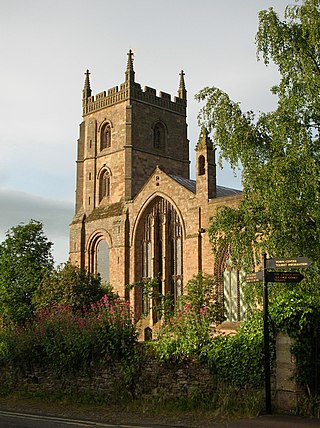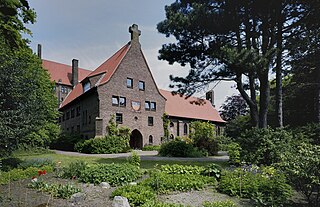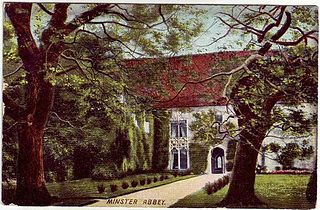
The Benedictines, officially the Order of Saint Benedict, are a mainly contemplative monastic order of the Catholic Church for men and for women who follow the Rule of Saint Benedict. Initiated in 529 they are the oldest of all the religious orders in the Latin Church. The male religious are also sometimes called the Black Monks, especially in English speaking countries, after the colour of their habits. Not all Benedictines wear black, however, with some like the Olivetans wearing white. They were founded by Benedict of Nursia, a 6th-century Italian monk who laid the foundations of Benedictine monasticism through the formulation of his Rule. Benedict's sister, Scholastica, possibly his twin, also became a religious from an early age, but chose to live as a hermit. They retained a close relationship until her death.

Ramsey Abbey was a Benedictine abbey in Ramsey, Huntingdonshire, England. It was founded about AD 969 and dissolved in 1539.

Chatteris is a market town and civil parish in the Fenland district of Cambridgeshire, England, situated in the Fens between Huntingdon, March and Ely. The town is in the North East Cambridgeshire parliamentary constituency.

Denny Abbey is a former abbey near Waterbeach, about 6 miles (10 km) north of Cambridge in Cambridgeshire, England. It is now the Farmland Museum and Denny Abbey.

Spinney Abbey, originally known as Spinney Priory, is a house and farm on the site of a former monastic foundation close to the village of Wicken, on the edge of the fens in Cambridgeshire, England.

Garsten Abbey is a former Benedictine monastery located in Garsten near Steyr in Upper Austria. Since 1851, the former monastery buildings have accommodated a prison.
St Mary's Abbey, also known as Malling Abbey, is an abbey of Anglican Benedictine nuns located in West Malling, Kent, England. It was founded around 1090 by Gundulf, Bishop of Rochester and dissolved in 1538. The site became a monastery again in the late 19th century.

Thorney Abbey, now the Church of St Mary and St Botolph, was a medieval English Benedictine monastery at Thorney, Cambridgeshire in The Fens of Cambridgeshire, United Kingdom

Stanbrook Abbey is a Catholic contemplative Benedictine Monastery with the status of an abbey, located at Wass, North Yorkshire, England.
Amesbury Abbey was a Benedictine abbey of women at Amesbury in Wiltshire, England, founded by Queen Ælfthryth in about the year 979 on what may have been the site of an earlier monastery. The abbey was dissolved in 1177 by Henry II, who founded in its place a house of the Order of Fontevraud, known as Amesbury Priory.

Eadnoth the Younger or Eadnoth I was a medieval monk and prelate, successively Abbot of Ramsey and Bishop of Dorchester. From a prominent family of priests in the Fens, he was related to Oswald, Bishop of Worcester, Archbishop of York and founder of Ramsey Abbey. Following in the footsteps of his illustrious kinsman, he initially became a monk at Worcester. He is found at Ramsey supervising construction works in the 980s, and around 992 actually became Abbot of Ramsey. As abbot, he founded two daughter houses in what is now Cambridgeshire, namely, a monastery at St Ives and a nunnery at Chatteris. At some point between 1007 and 1009, he became Bishop of Dorchester, a see that encompassed much of the eastern Danelaw. He died at the Battle of Assandun in 1016, fighting Cnut the Great.

Wroxall Abbey is a substantial Victorian mansion house situated at Wroxall, Warwickshire which was converted for use as a hotel, spa, wedding venue and conference centre. It is a Grade II listed building.

Leominster abbey was an Anglo-Saxon monastery established at Leominster in the county of Hereford, England. The name of the town refers to its minster, a settlement of clergy living a communal life.
St. Mary's Abbey, also known as the Nunnaminster, was a Benedictine nunnery in Winchester, Hampshire, England. It was founded between 899 and 902 by Alfred the Great's widow Ealhswith, who was described as the 'builder' of the Nunnaminster in the New Minster Liber Vitae. The first buildings were completed by their son, Edward the Elder. Among the house's early members was Edward's daughter Edburga.

Egmond Abbey or St. Adalbert's Abbey is a Benedictine monastery of the Congregation of the Annunciation, situated in Egmond-Binnen, in the municipality of Bergen, in the Dutch province of North Holland. Founded in 920-925, and destroyed during the Reformation, it was re-founded in 1935 as the present Sint-Adelbertabdij, in the Diocese of Haarlem.

St Radegund's Priory, Cambridge was a Benedictine nunnery in Cambridge, Cambridgeshire, England. It was founded before 1144 and dissolved in 1496 by the initiative of John Alcock, Bishop of Ely.
Swavesey Priory was a medieval monastic house in the village of Swavesey, Cambridgeshire, England. A church existed in Swavesey at the time of the Norman Conquest, when Alan, Count of Richmond, granted it to the Benedictine Abbey of St Sergius and St Bacchus in Angers, France. The Abbey founded an alien priory in Swavesey by 1086. It ceased to function in 1539, during the dissolution of the monasteries. The site is now a scheduled monument.

Minster Abbey is the name of two abbeys in Minster-in-Thanet, Kent, England. The first was a 7th-century foundation which lasted until the Dissolution of the Monasteries. Beside its ruins is St Mildred's Priory, a Benedictine community of women founded in 1937.

Nuneaton Priory was a medieval Benedictine monastic house in Nuneaton, Warwickshire, England. It was founded as a daughter house of the Order of Fontevraud in 1153.
















